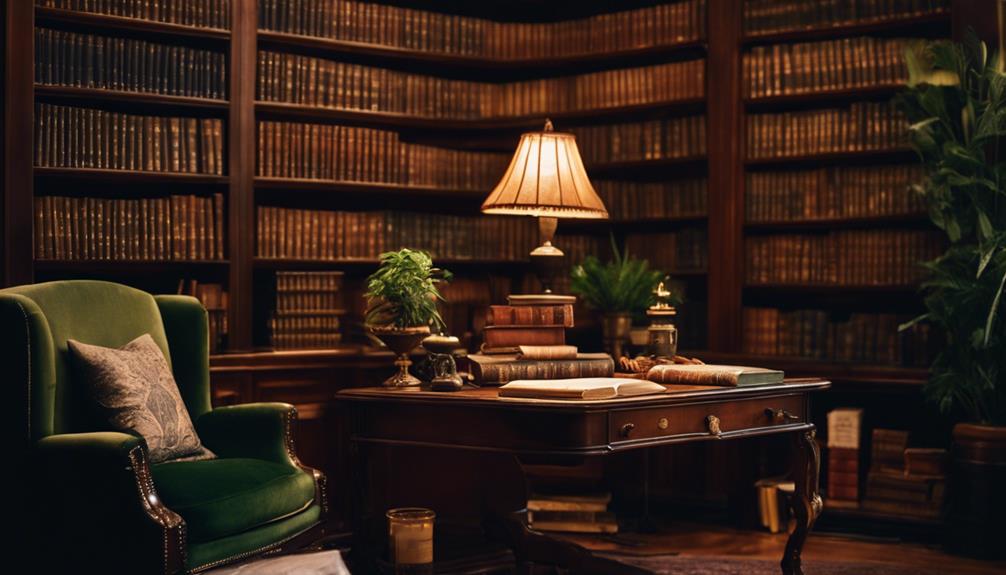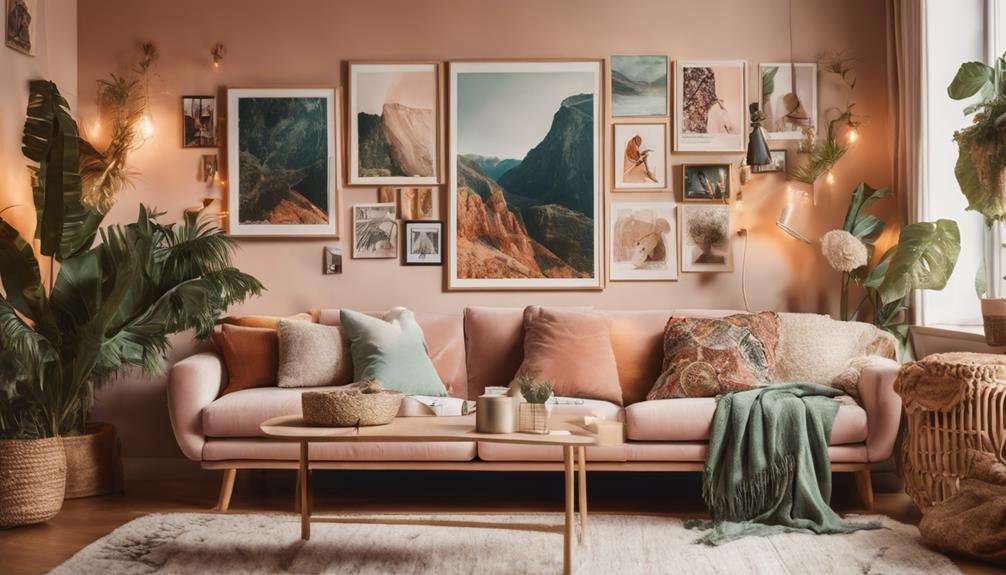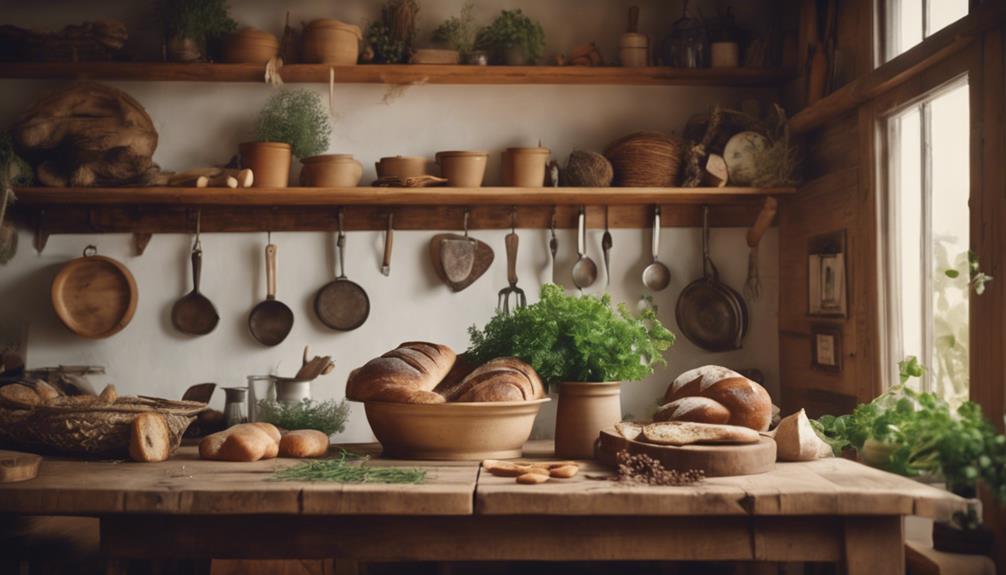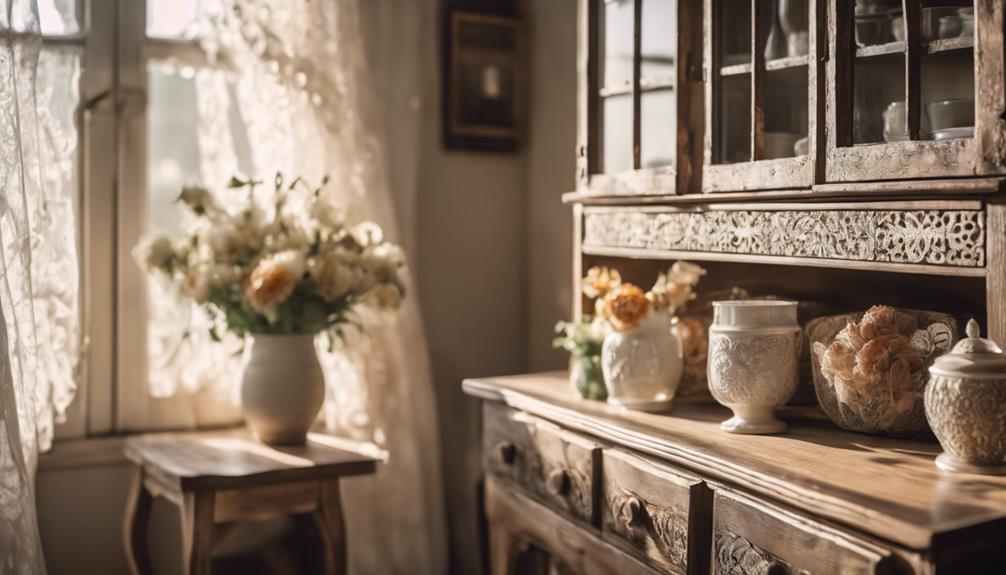To impress everyone with your dark academia room decor, focus on deep, warm tones like burgundy and forest green. Incorporate vintage furniture, such as an antique wooden writing desk and a leather armchair, to create a cozy, scholarly vibe. Layer your space with rich textiles and warm lighting, like candle sconces and vintage table lamps. Add decorative elements, like an antique globe or vintage botanical prints, to spark curiosity. Don't forget to choose flooring that complements the overall aesthetic, like dark hardwood or a plush area rug. Keep exploring to uncover even more inspiring ideas for your dark academia sanctuary!
Key Elements

To achieve the dark academia aesthetic, focus on your color scheme, materials, and textures.
You'll want to embrace deep, warm tones and incorporate vintage elements that evoke a sense of history.
Layering different fabrics won't only enhance comfort but also add depth to your space, inviting you to get lost in your studies.
Color Scheme
The dark academia color scheme embraces deep, warm tones like dark brown, burgundy, and forest green, inviting you into a space that feels both cozy and intellectually stimulating. This rich color palette creates an atmosphere filled with nostalgia and sophistication, perfect for fostering creativity and scholarly pursuits.
To enhance the overall aesthetic, consider adding accent colors such as gold and dark orange. These shades provide depth and contrast, balancing the darker tones with vibrant highlights. When selecting vintage furniture and decor, choose items that align with this color scheme, particularly those made from wood and leather, as they naturally complement the earthy hues.
Layering textiles is another way to embody the dark academia vibe. Opt for patterned throws and velvet pillows in rich colors to boost the cozy feel of your space.
Additionally, incorporating warm lighting sources, like candles and fairy lights, can elevate the ambiance. This not only emphasizes your chosen color palette but also creates a soft, inviting glow that encourages reflection and study.
Embrace these elements, and you'll transform your room into a true haven of dark academia charm.
Materials
Creating a dark academia aesthetic involves carefully selecting materials that enhance the rich, textured atmosphere of your space. Start with vintage wood for furniture, as it exudes a timeless charm that aligns perfectly with this scholarly style.
Opt for parchment or leather for your journal covers; these materials not only look sophisticated but also invite you to reflect on your thoughts as you write.
Incorporate antique or second-hand items like globes, steamer trunks, and old books to add authenticity and depth to the aesthetic. Natural materials such as stone and metal can serve as elegant decor elements, whether in the form of sculptures or candle holders. These details contribute to the rustic elegance characteristic of the dark academia aesthetic.
Layer textiles like velvet and wool for upholstery and curtains to create a warm, inviting environment. Don't forget to add Persian rugs or knitted throws for that extra touch of comfort.
Textures
Textures are essential in dark academia decor, as they layer materials like wool, velvet, and linen to craft a cozy, inviting atmosphere.
To achieve this aesthetic, you should incorporate vintage textiles, such as Persian rugs or embroidered throws, which add warmth and elegance to your space. Natural fibers like cotton, tweed, and leather are ideal choices for your furniture and accessories, contributing to the overall richness and authenticity of the decor.
Don't shy away from mixing and matching patterns, like plaid and tartan, in your upholstery and wall coverings. This creates visual interest while maintaining the moody undertones characteristic of dark academia.
You'll also want to explore textural contrasts by pairing smooth surfaces with rough, aged finishes. This technique can create a dynamic environment that reflects the complexity and depth of the theme.
Essential Fixtures and Furniture

To truly capture the essence of dark academia, you need key pieces like an antique wooden writing desk and a vintage leather armchair.
A gothic-style bookshelf can serve as both a functional storage solution and a striking focal point for your literary collection.
Together, these fixtures will create a sophisticated and inviting atmosphere that reflects your intellectual pursuits.
Antique Wooden Writing Desk
An antique wooden writing desk serves as a striking focal point in any dark academia-themed space, embodying the timeless elegance and intellectual spirit of the aesthetic. This quintessential centerpiece not only reflects vintage charm but also enhances your study area with its intricate carvings and rich wood tones.
When you incorporate an antique wooden writing desk, you're creating a functional workspace designed for scholarly pursuits, whether that's studying or writing.
To cultivate an inviting environment, style the desk with essential dark academia elements. Leather-bound journals, vintage ink pens, and stacks of classic novels can transform your desk into a haven of creativity and inspiration. It's not just about functionality; it's about curating a space that resonates with your intellectual passions.
For maximum aesthetic appeal, consider pairing the desk with a comfortable upholstered chair and warm lighting options, like a vintage desk lamp. This combination fosters a cozy atmosphere, making it the perfect spot for deep thinking and reflection.
Ultimately, an antique wooden writing desk is more than just furniture; it's a statement piece that embodies the essence of dark academia.
Vintage Leather Armchair
A vintage leather armchair instantly adds warmth and character to your dark academia space, making it the perfect retreat for diving into classic literature or pondering your next big idea. This quintessential piece not only provides an inviting spot for reading but also enhances your room's scholarly atmosphere. The rich texture and deep, warm tones of leather beautifully complement the darker color palette typical of the aesthetic.
When choosing your vintage leather armchair, consider styles with intricate detailing like tufted backs or carved wooden legs, which elevate the vintage appeal and add a touch of sophistication. Opting for a well-worn or distressed leather armchair brings authenticity and character, reflecting the romantic nostalgia associated with traditional academic environments.
Incorporating a vintage leather armchair into your space serves practical purposes and acts as a statement piece, encouraging a love for literature and intellectual pursuits. It's a place where you can curl up with a book or engage in deep thought, making it an essential fixture in your dark academia decor.
Gothic-Style Bookshelf
Adding a gothic-style bookshelf to your dark academia room not only showcases your literary collection but also enhances the overall aesthetic with its intricate architectural details and rich, dark finishes.
These bookshelves often feature pointed arches, ornate carvings, and tall, narrow designs that mimic the height of cathedral windows, creating an elegant verticality perfect for displaying classic literature.
To elevate the gothic allure, incorporate elements like wrought iron accents, vintage brass hardware, and distressed finishes. This combination makes the bookshelf a striking focal point in your space.
As you arrange your collection, consider showcasing antique books and leather-bound volumes alongside botanical prints to foster a scholarly atmosphere that encourages a love for learning.
Further enhance the gothic ambiance by adding decorative elements like candle holders, small sculptures, or framed artwork that reflect dark academia themes.
These additions not only complement the gothic-style bookshelf but also create a cohesive design that immerses you in the intellectual and aesthetic pursuits of the dark academic lifestyle.
Embrace this timeless elegance and let your bookshelf become a true representation of your literary passion.
Lighting Ideas

When it comes to lighting in your dark academia room, consider using candle sconces on dark walls to create an intimate atmosphere.
Vintage table lamps with shades add both charm and functionality, while a chandelier with crystal accents can serve as a stunning focal point.
Don't forget soft ambient fairy lights to provide a whimsical glow that enhances the overall aesthetic.
Candle Sconces on Dark Walls
Candle sconces on dark walls create a warm, inviting glow that perfectly complements the dark academia aesthetic. These sconces not only provide ambient lighting but also enhance the cozy atmosphere ideal for studying or reading. Opt for antique or vintage-style candle sconces to infuse an element of elegance and sophistication that aligns with the gothic and neoclassical influences of your decor.
When you choose deep greens, burgundies, or navy blues for your walls, these colors serve as a dramatic backdrop for your candle sconces. The flickering candlelight stands out beautifully, creating a sense of intimacy in the space. To add visual interest, consider strategically placing your sconces at varying heights. This layered approach makes your room feel thoughtfully designed, a key element in dark academia decor.
Don't forget to incorporate scented candles in your sconces. Fragrances like sandalwood or amber can evoke the scholarly vibe reminiscent of old libraries and study halls. By thoughtfully selecting candle sconces and their placements, you'll elevate your space into a sophisticated sanctuary that truly embodies the dark academia spirit.
Vintage Table Lamps With Shades
Vintage table lamps with shades enhance the warm, inviting glow created by candle sconces, making them perfect for achieving the dark academia aesthetic. These lamps play a vital role in creating the moody atmosphere characteristic of this style. Look for vintage table lamps with shades that feature antique finishes like brass or wrought iron. These materials not only add a scholarly touch but also harmonize beautifully with the earthy color palettes typical of dark academia decor.
When selecting lamps, opt for fabric shades in rich tones such as burgundy, forest green, or cream. These colors introduce texture and depth, complementing the layered textiles often found in dark academia spaces. Additionally, consider lamps with ornate designs or vintage patterns. These unique details can serve as conversation starters and reflect the intellectual pursuits associated with the aesthetic.
Incorporating vintage table lamps in reading nooks or study areas provides functional lighting while reinforcing the cozy, nostalgic vibe that dark academia enthusiasts cherish. By choosing the right vintage table lamps with shades, you'll not only enhance the ambiance of your space but also deepen your connection to the scholarly spirit that defines dark academia.
Chandeliers With Crystal Accents
Chandeliers with crystal accents make striking focal points in dark academia decor, effortlessly enhancing the vintage and gothic atmosphere. These elegant lighting fixtures often feature intricate designs that beautifully reflect light, adding sophistication and warmth to your study areas or reading nooks.
When you choose warm-toned bulbs for your crystal chandelier, you create a cozy ambiance that aligns perfectly with the dark academia aesthetic's preference for inviting, layered lighting.
You can discover vintage-inspired chandeliers with crystal accents at flea markets, estate sales, or online platforms, ensuring a unique and character-rich addition to your space. Incorporating these lighting pieces not only elevates the visual appeal but also brings a sense of history and charm to your surroundings.
Moreover, look for chandeliers with adjustable heights or dimmable features, as this versatility allows you to cater to different moods and activities. Whether you're focused on studying or enjoying a relaxed reading session, chandeliers with crystal accents can set the perfect tone.
Embrace the elegance of these fixtures, and let them illuminate your dark academia sanctuary.
Soft Ambient Fairy Lights
Soft ambient fairy lights transform any space into a cozy haven, perfect for embracing the dark academia aesthetic. These lights are essential for creating a warm and inviting atmosphere that enhances the scholarly vibe of your room. You can strategically place soft ambient fairy lights around bookshelves, windows, or wall art to highlight your personal collections and add a whimsical touch to your intellectual space.
Opt for warm-toned fairy lights, like soft white or amber, to complement the dark academia color palette featuring deep browns, greens, and burgundies. You'll find that these colors work beautifully with the overall decor. Arrange your fairy lights in various styles; drape them along the ceiling or weave them through plants to achieve the desired aesthetic.
Consider incorporating fairy lights with dimmers or timers. This allows you to customize your lighting levels, making them perfect for late-night study sessions or creating a tranquil reading nook.
With soft ambient fairy lights, you'll effortlessly elevate your dark academia decor, making your space not only visually stunning but also a comforting retreat for your scholarly pursuits.
Decorative Elements

To create a truly enchanting dark academia space, you'll want to incorporate decorative elements that spark curiosity.
An antique globe on a wooden stand can serve as a stunning focal point, while framed vintage botanical prints add a touch of nature's elegance.
Don't forget an antique quill and ink set to evoke a sense of scholarly charm and nostalgia.
Antique Globe on Wooden Stand
An antique globe on a wooden stand instantly transforms your space into an enchanting blend of adventure and scholarly elegance, inviting exploration and intellectual curiosity. This striking centerpiece not only enhances your decor but also sparks conversations about geography and history. Featuring vintage cartography, these globes showcase historical boundaries and names that add depth to your decor while enriching your knowledge.
The warm, natural tones of the wooden stand beautifully complement the dark, moody color palettes typical of dark academia. Whether you place a smaller globe on your study desk or a larger one on an expansive bookshelf, they fit seamlessly into any environment, typically ranging from 12 to 30 inches in diameter.
Incorporating an antique globe into your decor serves a dual purpose: it enriches visual interest and encourages engagement with the world beyond your immediate surroundings. With each glance, you'll be reminded of the adventures that await in distant lands.
Framed Vintage Botanical Prints
Framed vintage botanical prints bring an air of scholarly elegance to your space, perfectly embodying the dark academia aesthetic. These prints often feature intricate illustrations of plants and flowers from 18th and 19th-century botanical studies, showcasing the beauty of historical artistry and scientific illustration. By incorporating framed vintage botanical prints into your decor, you add a touch of sophistication that enhances the moody, vintage atmosphere characteristic of dark academia.
To create a visually striking display, consider using mismatched frames. This eclectic approach forms an enthralling gallery wall, emphasizing the charm of curated chaos and personal storytelling. Each print tells a story, inviting curiosity and conversation, which is essential in dark academia spaces.
Finding these prints is easier than you might think. You can often discover them in thrift stores, antique shops, or online marketplaces, making them an accessible and affordable way to enrich your decor.
Antique Quill and Ink Set
Incorporating an antique quill and ink set into your decor instantly adds a touch of elegance and nostalgia, perfectly complementing the dark academia aesthetic. This striking decorative element evokes the romanticism of classic literature and the art of writing by hand. You'll find that these sets often feature ornate designs, with quills made from feathers and ink wells crafted from glass or ceramic, making them eye-catching additions to your study space or bookshelves.
Displaying an antique quill and ink set alongside vintage books or botanical illustrations creates a cohesive look that enhances the scholarly atmosphere characteristic of dark academia. It not only beautifies your space but also inspires creativity, encouraging you to journal, compose poetry, or write heartfelt letters.
You can easily find antique quill and ink sets at flea markets, antique shops, or online marketplaces, ensuring that you get a unique piece that reflects your personal style. By integrating this charming decorative element into your room, you'll foster an environment that celebrates the written word and the beauty of scholarly pursuits.
Flooring

When you think about flooring for your dark academia space, consider dark hardwood with intricate inlays to add elegance and depth.
A plush area rug in a deep green can provide a cozy touch, while distressed slate tile flooring brings a unique, historical feel.
Each choice contributes to an atmosphere that invites study and reflection, perfectly aligning with the dark academia aesthetic.
Dark Hardwood With Intricate Inlays
Dark hardwood flooring with intricate inlays instantly elevates the ambiance of your dark academia-inspired space, blending elegance with a scholarly vibe. The deep tones of mahogany or walnut create a rich backdrop that enhances the warm color palette typically found in dark academia, fostering a cozy environment perfect for study or reflection.
Intricate inlays, often made from contrasting woods, can feature classical motifs or geometric patterns, adding a vintage charm that resonates with the theme of academia. These details not only enhance the aesthetic appeal but also evoke a sense of nostalgia, reminiscent of historic libraries and prestigious institutions.
Opting for dark hardwood flooring is also a practical choice, as it's durable enough to withstand heavy foot traffic. This resilience makes it ideal for spaces dedicated to intellectual pursuits.
Plus, the rich textures and natural variations in the wood can add depth to your room, creating a warm and inviting atmosphere that encourages creativity and learning.
Plush Area Rug in Deep Green
A plush area rug in deep green instantly warms up your dark academia-inspired room, creating a cozy atmosphere that invites both relaxation and study. This rich hue not only symbolizes knowledge and growth but also enhances the overall aesthetic of your space. When you choose a deep green rug, it can help tie together various decor elements, such as vintage furniture and classic literature, fostering a cohesive scholarly environment.
The texture of a plush rug adds an inviting focal point, perfect for layering with blankets and cushions to achieve a dynamic look. Consider opting for a rug with intricate patterns or motifs; this can evoke a sense of history and sophistication, further enriching your room's ambiance. The deep green color will complement the dark hardwood flooring and other elements you've carefully selected, making your space feel more unified and intentional.
Incorporating a plush area rug isn't just about comfort; it's a strategic design choice that elevates your dark academia aesthetic. So, take the plunge and add this essential piece to create warmth and charm in your intellectual haven.
Distressed Slate Tile Flooring
Transform your space with distressed slate tile flooring, which offers a textured surface and rich color variations that perfectly capture the essence of dark academia. The deep grays, blues, and greens of this flooring create a moody atmosphere, making it an excellent choice for study areas or libraries. Its durability means you won't have to worry about wear and tear from heavy foot traffic, allowing you to focus on your studies without distractions.
The natural, earthy tones of distressed slate tile flooring contribute warmth and coziness to your room, complementing your wooden furniture and vintage textiles beautifully. This flooring also enhances the acoustics of your space, creating a quieter environment ideal for reading and studying.
If you want to elevate your comfort during the colder months, consider incorporating radiant floor heating beneath the distressed slate tiles. This addition makes your study or reading area inviting during the fall and winter, seasons favored by dark academia enthusiasts.
With distressed slate tile flooring, you'll create a space that not only looks stunning but also feels comfortable and conducive to learning.
Conclusion
Incorporating dark academia decor into your space can truly transform it into a scholarly retreat.
By focusing on key elements like vintage furniture, rich textiles, and atmospheric lighting, you'll create an inviting environment that sparks creativity and intellectual curiosity.
Don't forget the decorative touches—books, art, and unique artifacts will add depth and character.
Embrace these ideas, and you'll impress everyone who steps into your beautifully curated haven of knowledge and aesthetic charm!









